Dental Amalgam Important Notes
1. Composition of amalgam
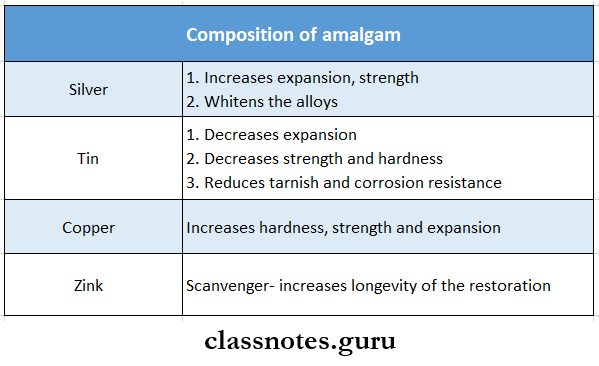
Mercury In Dental Amalgam
2. Classification of amalgam
- Based on copper content
- Low copper alloys contain less than 6% copper
- High copper alloys contain between 13-and 30% copper
- Based on zinc content
- Zinc-containing alloys
- Zinc-free alloys
- Based on the shape of the alloy particle
- Lathe-cut alloys
- Spherical alloys
- Based on the number of alloyed metals
- Binary alloys
- Tertiary alloys
- Quaternary alloys
- Based on the size of the alloy
- Microcut
- Macrocut
Dental Amalgam Composition Questions and Answers
3. Phases of amalgam
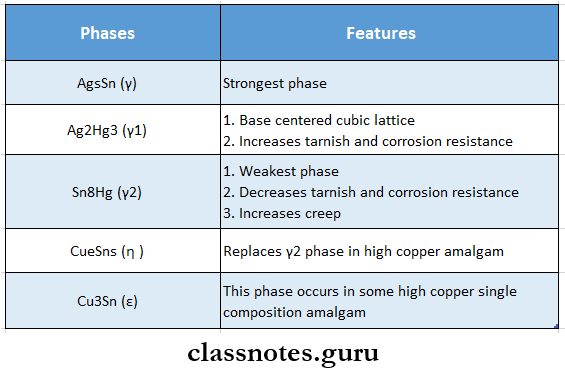
4. Setting reaction
- For low copper alloys
Ag3Sn + Hg → Ag2Hg3 + Sn8Hg + Ag3Sn (unreacted) - For high copper admixed alloys
γ + Ag-Cu + Hg → γ1 + Cu6Sn5 + (γ + Ag-Cu) unreacted - For high copper single composition alloys Ag-Sn-Cu + Hg → γ1 + η + unreacted alloy particles (γ)
Dental Amalgam Composition Questions and Answers
Read And Learn More: Dental Materials Question and Answers
5. Lathe cut and spherical alloys
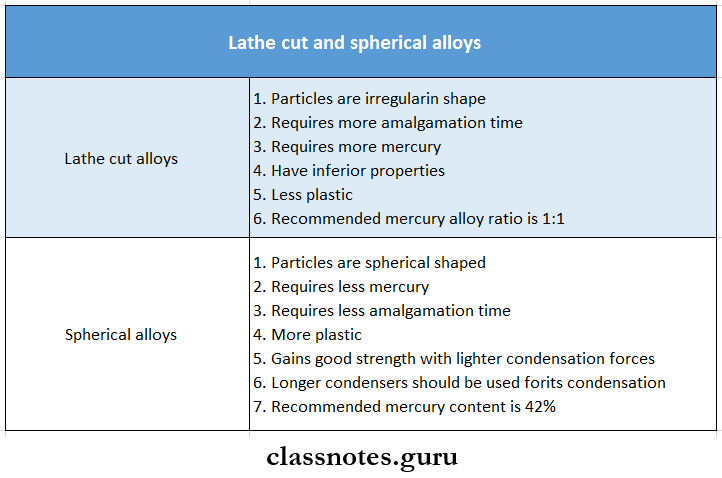
6. Eames’ technique
- It states the minimum mercury alloy ratio
- It should be 1:1
- The mercury content of the finished restoration should be approximately 50 wt%. For spherical alloys, it should be approximately 42 wt%
7. High copper alloys are superior to low copper alloys because:
- Higher resistance to tarnish, corrosion
- Lower creep
- High strength
- Elimination of SnHg phase
Alternatives to dental amalgam
8. Delayed expansion
- Occurs when zinc-containing alloys are contaminated with moisture during trituration or condensation
- Expansion reaches upto 400 pm/cm
- It occurs 3-4 days after insertion of amalgam
- It is due to the formation and accumulation of hydrogen gas in the restoration leading to pain, sensitivity, and proper sion of the restoration
Composition Of Dental Amalgam
9. Creep
- It is defined as the time-dependent plastic deformation
- The higher the creep, the greater the marginal deterioration
- Values:
- Low copper – 0.8-8%
- High copper – 0.4-0.1%
Components Of Dental Amalgam
10. Tarnish and corrosion products
- Tarnish product – Ag2S
- Corrosion product
- Low copper – SnO, Sn-O-Cl
- High copper – SnO, Sn-O-Cl, CuO
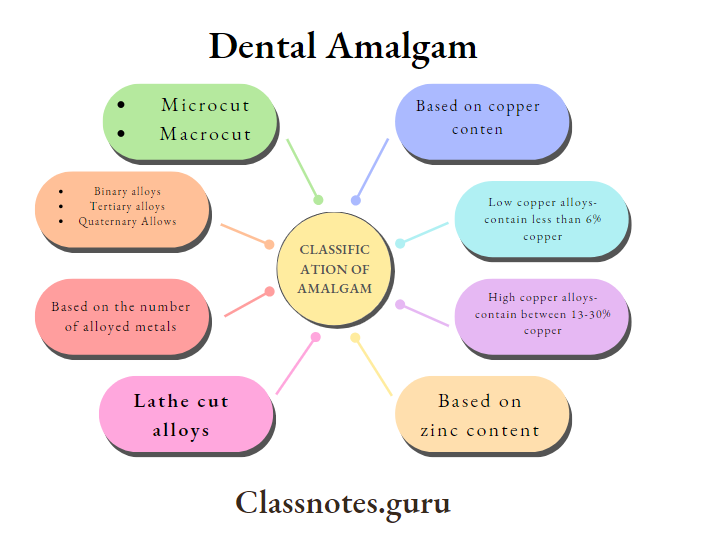
Alternatives to dental amalgam
Dental Amalgam Long Essays
Question 1. Discuss the type, properties, and uses of dental amalgam alloys. Add a note on high copper alloys.
Answer:
Dental Amalgam:
Dental amalgam is an alloy of mercury, silver, copper, and tin which may also contain palladium, zinc, and other elements to improve handling characteristics and clinical performance.
Dental Amalgam alloys Types:
- Based on copper content
- Low copper alloys- contain less than 6% copper
- High copper alloys- contain between 13-30% copper
- Based on zinc content
- Zinc containing alloys
- Zinc free alloys
- Based on the shape of the alloy particle
- Lathe cut alloys
- Spherical alloys
- Spherical alloys
- Based on the number of alloyed metals
- Binary alloys
- Tertiary alloys
- Quaternary alloys
- Based on size of the alloy
- Microcut
- Macrocut
Dental amalgam composition
Dental Amalgam alloys Properties:
- Dimensional stability
- Amalgam may expand or contract depending on its manipulation
- Severe contraction can lead to microleakage, plaque accumulation, and secondary caries
- Excessive expansion can produce pressure on the pulp and postoperative sensitivity
- It can also lead to the protrusion of restorations
- Effect of moisture contamination
- If a zinc-containing low copper or high copper amalgam is contaminated by moisture during trituration or condensation, a large expansion results
- It usually starts after 3-5 days and may continue for months
- This is called delayed expansion
- Strength
- It lacks of strength to resist masticatory forces and thus fractures
- Creep
- It is a slow progressive permanent deformation of set amalgam that occurs under constant stress
- Higher the creep magnitude the greater the degree of marginal deterioration
- Tarnish and corrosion
- Amalgam restorations often tarnish and corrode the oral environment
- Retention
- Amalgam does not adhere to tooth structure
- Retention is by mechanical locking
- Microleakage
- Amalgam is a self-sealing restoration
- They are capable of sealing against, microleakage
Dental Amalgam Uses
Dental Amalgam alloys Use:
- As permanent restorative material for
- Class 1 and class 2 cavities
- Class 5 cavities
- In combination with retentive pins to restore a crown
- For making dies
- In retrograde root canal filling materials
- As a core material
Dental amalgam composition
High Copper Alloys:
- Contains 13-30%, weight copper
- They are preferred because of
- Improved properties
- Resistance to corrosion
- Better marginal integrity
- Improved performance in clinical trials
Copper Alloys Types:
- Admixed alloys 0 Regular type
- Unicomposition alloy
- Single composition alloy
Copper Alloys Composition:
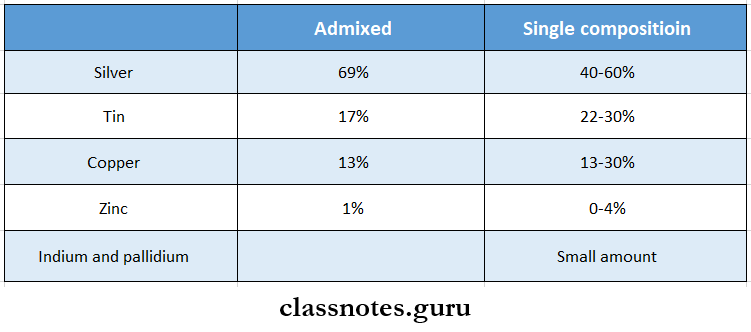
Dental amalgam properties
Copper Alloys Setting reaction:
1. Admixed alloy
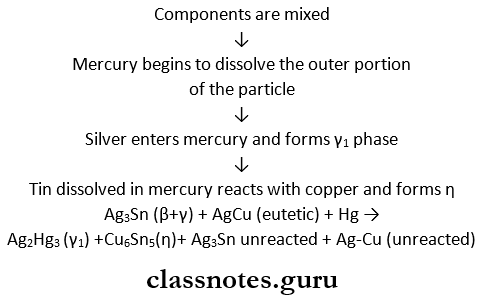
2. Single composition

Copper Alloys Advantages:
- Set fasts
- Low residual mercury
- Low creep
- Faster finishing
- High strength
- Low condensation pressure
Copper Alloys Disadvantages:
- Less working time
- Condensation pressure is not sufficient
Dental Amalgam Questions And Answers
Question 2. State various merits and demerits of dental amalgams
Answer:
Dental Amalgam:
Dental amalgam is an alloy of mercury, silver, copper, and tin which may also contain palladium, zinc, and other elements to improve handling characteristics and clinical performance.
Dental Amalgam Merits:
- Easy to insert
- Not technique sensitive
- Maintain anatomic form well
- Have adequate resistance to fracture
- Prevent marginal leakage after some time
- Have a reasonably long shelf life
Dental amalgam properties
Dental Amalgam Demerits:
- The color does not match the tooth color
- More brittle
- Less tough than desirable
- Subject to corrosion and galvanic action
- Show marginal breakdown
- Do not bond to tooth structure
Dental Materials Question And Answers
Question 3. Give the composition of dental amalgam alloys and write in detail about the manipulation and properties of high copper dental amalgam
Answer:
Amalgam alloys Composition:
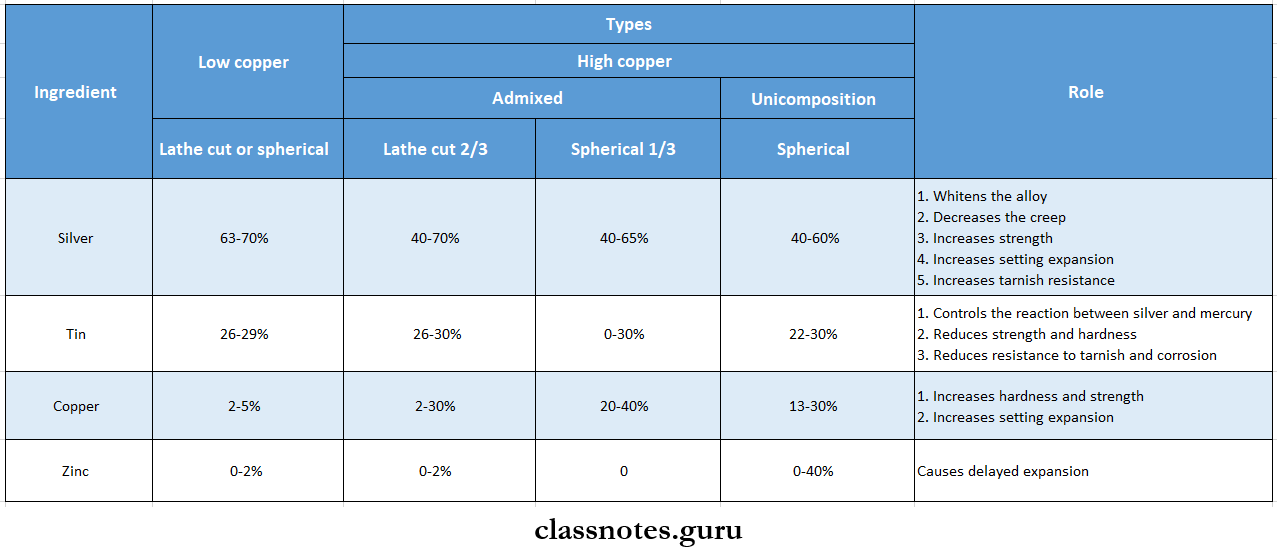
- Mercury
- It is added to the alloy
- Platinum
- Hardens the alloy
- Increases resistance to corrosion
- Palladium
- Hardens and whitens the alloy
- Indium
- Reduces mercury vapor and improves wetting
Amalgam alloys Manipulation:
1. Selection of materials
- Alloy selection
- For therapeutic purposes- high resistance amalgam is selected
- For strength- high copper alloys are selected
- If moisture control is difficult- non-zinc-containing alloys are selected
- Mercury: alloy ratio
- To achieve smooth and plastic amalgam an amount of mercury in excess is desirable
- But because of the harmful effects of excess mercury, it is necessary to reduce the amount of mercury
- One of the methods for it is to reduce the original mercury/alloy ratio
- This is called the Eames technique e Sufficient mercury must be present in the mix and it should be as low enough so that mercury content is acceptable during condensation
- Ratio is 1:1
2. Amalgam alloys Trituration
- Objective
- To wet all the surfaces of the alloy particles with mercury
- The film should be rubbed off to obtain a clean surface of alloy for mercury
- Manual mixing
- A glass mortar with a roughened inner surface and a pestle with a round end are used for mixing
- It depends on
- Number of rotations
- Speed of rotations
- Pressure placed on pestle
- Amalgam alloys Mechanical mixing
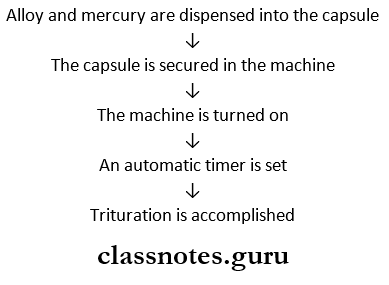
Dental Amalgam Components
3. Amalgam alloys Mulling
- It is a continuation of trituration
- It causes the mix to cohere so that it can be readily removed from the capsule
- Achieved by vigorously rubbing between first finger and thumb for 2-5 sec
4. Amalgam alloys Condensation
- Amalgam is placed in a prepared cavity and condensed using suitable condensers
- Aims
- To compact alloy into a prepared cavity
- To remove any excess mercury in each increment
- Reduces voids
Dental Materials Question And Answers
5. Amalgam alloys Carving and finishing
- Carved to reproduce proper tooth anatomy
- Smoothen through burnishing with a ball burnisher
- Final smoothening can be achieved by rubbing with a moist cotton pellet
- Polishing minimizes corrosion and prevents adherence to plaque
- It is delayed for 24 hours
- Wet polishing is desirable
Dental Amalgam Components
Amalgam alloys Properties:
- Dimensional stability
- Amalgam may expand or contract depending on its manipulation
- Severe contraction can lead to microleakage, plaque accumulation, and secondary caries
- Excessive expansion can produce pressure on the pulp and postoperative sensitivity
- It can also lead to the protrusion of restorations
- Effect of moisture contamination
- If a zinc-containing low copper or high copper amalgam is contaminated by moisture during trituration or condensation, a large expansion results
- It usually starts after 3-5 days and may continue for months
- This is called delayed expansion
- Amalgam alloys Strength
- It lacks of strength to resist masticatory forces and thus fractures
- Creep
- It is a slow progressive permanent deformation of set amalgam that occurs under constant stress
- Higher the creep magnitude the greater the degree of marginal deterioration
- Tarnish and corrosion
- Amalgam restorations often tarnish and corrode the oral environment
- Retention
- Amalgam does not adhere to tooth structure » Retention is by mechanical locking
- Microleakage
- Amalgam is a self-sealing restoration
- They are capable of sealing against, microleakage
Advantages And Disadvantages Of Dental Amalgam
Question 4. Write in brief about the setting reaction of both low and high copper amalgam alloy. What are the phases formed during the reaction with a note on factors affecting its strength?
Answer:
Setting Reactions:
1. Low Copper Amalgam Alloys:
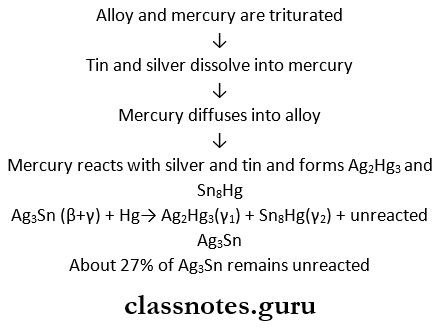
Uses Of Dental Amalgam
2. High Copper Amalgam:
Admixed alloy
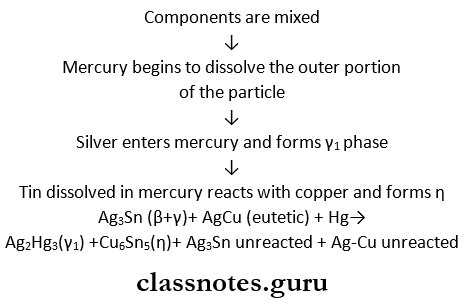
3. Single composition:
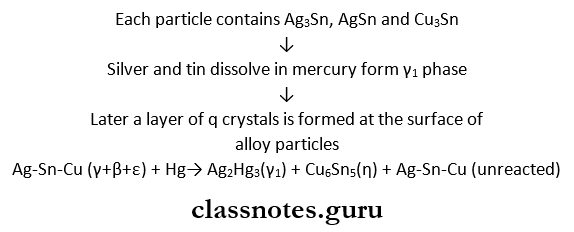
Amalgam Factors Affecting Strength:
- Effect of trituration
Under-triturated and over-triturated both decrease strength in both low and high-copper alloys
- Effect of mercury
- Sufficient mercury should be mixed with an alloy
- Any excess mercury left in the restoration decreases the strength
- For both low and high copper amalgam, if mercury content increases more than 54%, strength decreases
- Effect of condensation
- For lathe-cut alloys- greater condensation pressure, higher compressive strength
- For spherical alloys- lighter condensation pressure produces adequate strength
- Effect of porosity
- If porosities are greater, strength is lower
- Effect of amalgam hardening rate
- Amalgam does not gain strength rapidly
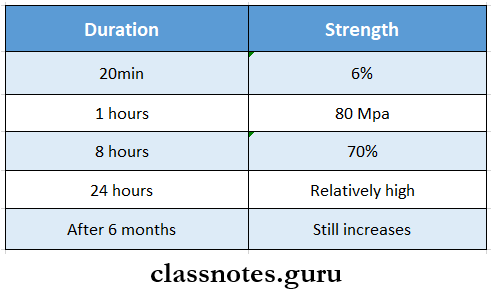
Types Of Dental Amalgam
Question 5. Write the composition, properties, advantages, and disadvantages of amalgam alloys. Add a note on the classification of amalgam alloys.
Answer:
Dental amalgam:
Dental amalgam is an alloy of mercury, silver, copper, and tin which may also contain palladium, zinc, and other elements to improve handling characteristics and clinical performance
Amalgam alloys Properties:
- Dimensional stability
- Amalgam may expand or contract depending on its manipulation
- Severe contraction can lead to microleakage, plaque accumulation, and secondary caries
- Excessive expansion can produce pressure on pulp and postoperative sensitivity
- It can also lead to protrusion of restoration
- Effect of moisture contamination
- If a zinc-containing low copper or high copper amalgam is contaminated by moisture during trituration or condensation, a large expansion results
- It usually starts after 3-5 days and may continue for months
- This is called delayed expansion
- Strength
Dental Amalgam Composition
- It lacks the strength to resist masticatory forces and thus fractures
- Creep
- It is a slow progressive permanent deformation of set amalgam that occurs under constant stress
- Higher the creep magnitude the greater the degree of marginal deterioration
- Tarnish and corrosion
- Amalgam restorations often tarnish and corrode the oral environment
- Retention
- Amalgam does not adhere to tooth structure
- Retention is by mechanical locking
- Microleakage
- Amalgam is a self-sealing restoration
- They are capable of sealing against microleakage
Amalgam alloys Advantages:
- Easy to insert
- Not technique sensitive
- Maintain anatomic form well
- Have adequate resistance to fracture
- Prevent marginal leakage after some time
- Have a reasonably long shelf life
Amalgam alloys: Disadvantages:
- Color does not match with tooth color
- More brittle
- Less tough than desirable
- Object to corrosion and galvanic action
- Show marginal breakdown
- Do not bond to tooth structure
Uses Of Dental Amalgam
Amalgam alloys Classification:
1. Based on copper content
- Low copper alloys contain less than 6% copper
- High copper alloys contain between 13-30% copper
2. Based on zinc content
- Zinc containing alloys
- Zinc free alloys
3. Based on the shape of alloy particles
- Lathe cut alloys
- Spherical alloys
4. Based on the number of alloy metals
- Binary alloys
- Tertiary alloys
- Quaternary alloys
5. Based on size of alloys
- Microcut
- Macrocut
Components Of Dental Amalgam
Setting Reaction Of Dental Amalgam
Dental Amalgam Short Essays
Question 1. Trituration
Answer:
Trituration Objective:
- To wet all the surfaces of the alloy particles with mercury
- The film should be rubbed off to obtain a clean surface of alloy for mercury
Trituration Types:
- Trituration Manual mixing
- A glass mortar with a roughened inner surface and a pestle with a round end are used for mixing
- It depends on
- Number of rotations
- Speed of rotations
- Pressure placed on pestle
Trituration Advantages of Mechanical Mixing:
- Shorter mixing time
- More standardized procedure
- Requires less mercury
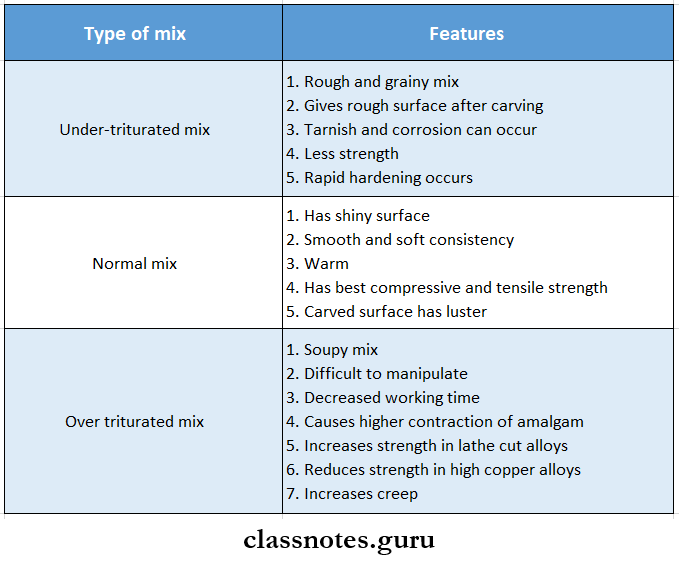
Dental Amalgam Setting Reaction
Question 2. Spherical amalgam alloys
Answer:
Spherical amalgam alloys
- Spherical amalgam alloy is prepared by the atomization process
- The liquid alloy is sprayed under high pressure of inert gas through a fine crack into a large chamber
Spherical amalgam alloys Features:
- Particles are small
- Manufactured by atomization process
- More plastic
- Need wedged matrix to establish proximal contour
- Require less mercury
- Particle size is- 5-40 pm
Spherical amalgam alloys Reactions:
- When triturated with mercury, silver, and tin dissolve in mercury
- γ1 crystals grow forming a matrix that binds together the partially dissolved alloy particles
Spherical amalgam alloys Composition:
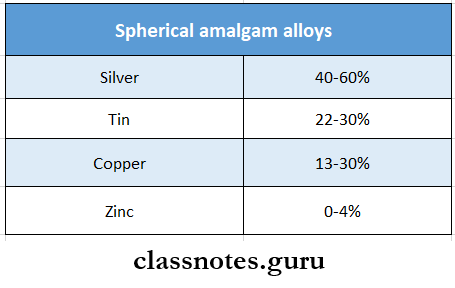
Dental Amalgam Toxicity
Question 3. Amalgam capsule
Answer:
Amalgam capsule
- A capsule serves as a mortar
- A cylindrical metal or plastic piston of a smaller diameter than the capsule is inserted into the capsule and this serves as a pestle
- Alloy powder and mercury are separated by a membrane in it
- Before use the membrane is ruptured by compressing capsule and then placed in an amalgamator
Amalgam capsule Advantages:
- Consistent proportioning
- Low mercury/alloy ratio
- Physical handling is not required
Amalgam capsule Disadvantages:
- Mercury and alloy may leak
- Expensive
- Mercury hazards
Dental Amalgam Setting Reaction
Question 4. Delayed expansion of amalgam
Answer:
Delayed expansion of amalgam
- If a zinc-containing low copper or high copper amalgam is contaminated by moisture during trituration or condensation a large expansion results
- It usually starts after 3-5 days and may continue for months
- This is called delayed expansion
- H2O+ Zn → ZnO + H2 (gas) .
- This hydrogen gas does not combine with the amalgam but collects within the restoration, creating extreme internal pressure and expansion of the mass
- This causes
- Protrusion of the restoration
- Increased creep
- Increased microleakage
- Pitted surfaces and corrosion
- Dental pain
- Recurrence of caries
- Fracture of restoration
Dental Amalgam Uses
Question 5. Eames technique
Answer:
Eames technique
- To achieve smooth and plastic amalgam an amount of mercury in excess is desirable
- But because of the harmful effects of excess mercury, it is necessary to reduce the amount of mercury
- One of the methods for it is to reduce the original mercury or alloy ratio
- This is called the Eames technique
- Sufficient mercury must be present in the mix and it should be as low enough so that mercury content is acceptable during condensation
- Ratio is 1:1
Dental Amalgam Short Question And Answers
Question 1. High copper alloy
Answer:
High copper alloy
- Contains 13-30%, weight copper
- They are preferred because of
- Improved properties
- Resistance to corrosion
- Better marginal integrity
- Improved performance in clinical trials
High copper alloy Types:
- Admixed alloys
- Regular type
- Unicomposition alloy
- Single composition alloy
High copper alloy Advantages:
- Set fasts
- Low residual mercury
- Low creep
- Faster finishing
- High strength
- Low condensation pressure
High copper alloy Disadvantages:
- Less working time
- Condensation pressure is not sufficient
Dental Amalgam Setting Reaction
Question 2. Creep in amalgam
Answer:
Creep in amalgam
- It is a slow progressive permanent deformation of set amalgam that occurs under constant stress
- Higher the creep magnitude the greater the degree of marginal deterioration
- According to ADA’s specification, no 1 creep should be below 3%
Creep in amalgam Creep Values:
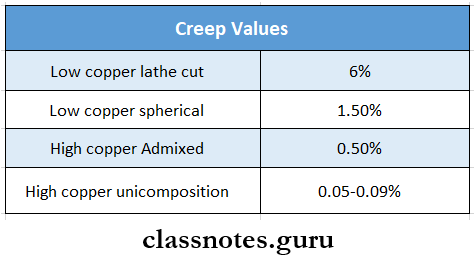
Creep in amalgam Factors Affecting Creep:
- Microstructure
- Manipulation
Question 3. Amalgam bond
Answer:
Amalgam bond
- Recently bonding agents like M-R-X type coupling agents have achieved success
- One system uses 4-methacryloxyethyl trimellitate anhydride
- Amalgam bonding agents have a place as an adjuvant to conventional retentive means if properly employed
Amalgam bond Mechanism Of Bonding:
- Bonding is mechanical
- Produced by condensing plastic amalgam mass into a plastic resin layer
- This produces macroretentive areas within the resin
Mercury In Dental Amalgam
Question 4. Gamma 2 phase in silver amalgam
Answer:
Gamma 2 phase in silver amalgam
The formula of γ2 is Sn8Hg
Gamma 2 phase in silver amalgam Importance:
- Weakest phase
- Decreases tarnish and corrosion resistance
- Increases creep
Dental Materials Question And Answers
Question 5. Mercury hygiene
Answer:
Mercury hygiene
- Follow aseptic technique
- Should have proper knowledge about mercury disposal and storage
- Use of proper ventilation
- Check mercury levels periodically
- Avoid carpet or floor covering
- Storage of mercury in a closed container in an isolated area
- Use of pre-capsulated alloy
- Use of amalgamators
- Polishing along with coolant
- Avoid direct contact with skin
- Use of evacuators
- Disposal in a closed plastic container
- Clean spilled mercury
- Remove protective clothing before leaving the operating area
Dental Amalgam Setting Reaction
Question 6. Advantages of high copper amalgam
Answer:
Advantages of high copper amalgam
- Set fasts
- Low residual mercury
- Low creep
- Faster finishing
- High strength
- Low condensation pressure
